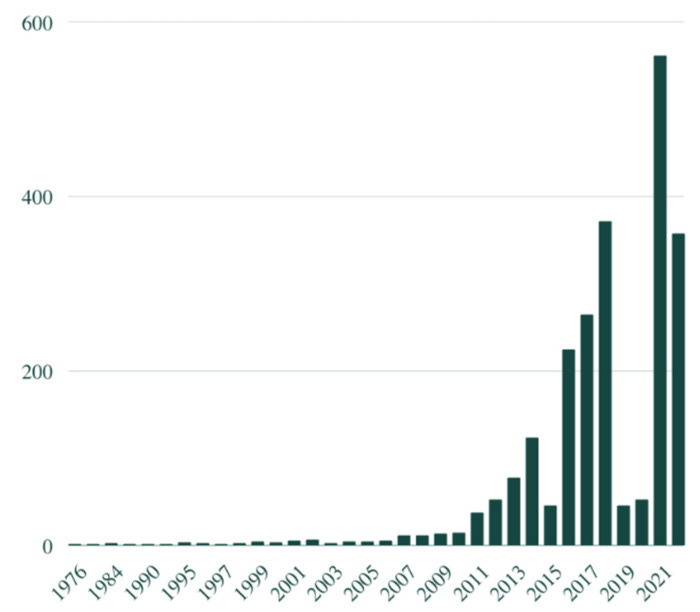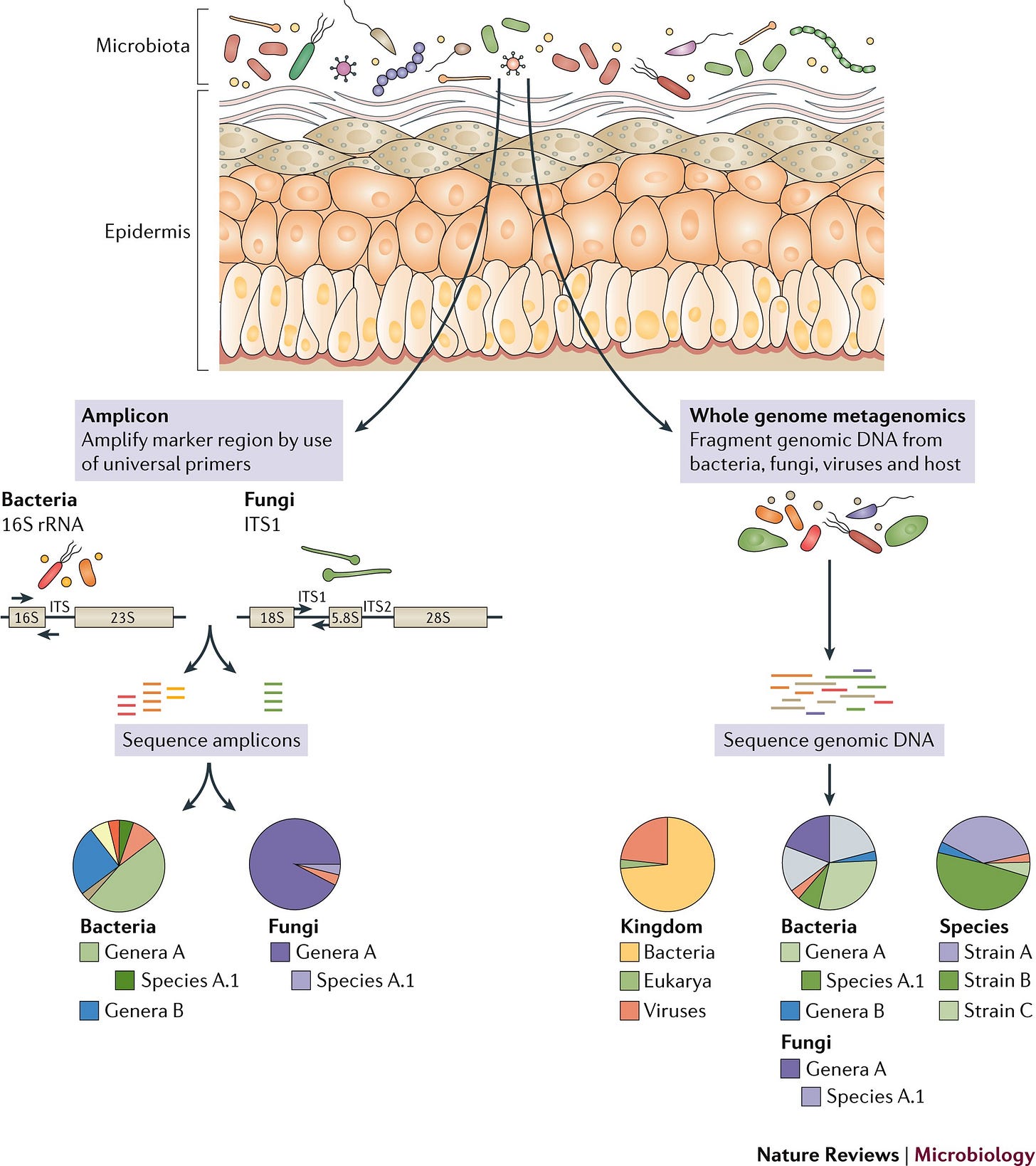Human Microbiome
What it is or isn't
What comes to mind when you see or hear human microbiome? Do you think of your gut? Are there other areas such as the skin? Where else can you find microbiome? What are some of the myth and misconception?
Research into the human microbiome have greatly increased by leaps and bounds, the past twenty years. We are seeing an growth of papers/articles on this.
The number of articles published on microbiota history or microbiome history or gut-brain axis history. Graph created with Canva tool.
Ever since Antony Van Leeuwenhoek (credited with being the first microbiologist) observed and drew/described his observations of “animalcules”), the true scientific work of studying microbes began in earnest. However, compound -microscopes preceded him actually been around since 1590. Nonetheless, though self-taught, he created hundreds of lens and invented the single lense microscope. His work improved magnification up to 300x and observed bacteria, protists, nematodes, and spermatozoa, among other things. “He examined and “drew the “animalcules” (from the Latin for “little animals”) of his own semen after sex. (Mrs. van Leeuwenhoek’s opinion that famous event does not seem to have been reported.)”
https://daily.jstor.org/the-evolution-of-the-microscope/
So , I will be focusing mainly on GI microbiome but with awareness of the microbiome community that resides externally as well as internally. To quote Dr. Jeremy Stone a character in Andromeda Strain: “We face quite a problem: how to disinfect the human body, one of the dirtiest things in the known universe.”. Acknowledging that we indeed carry our own colony of microorganism, it’s something that evolved with peaceful (mostly) coexistence. Microbial symbiosis is clearly interwoven into life on this planet and are essential to survival. I wouldn’t use the term dirtiest but rather “microbial commensal mutualism”. To better understand this, read: What is a Symbiotic Microbial Community?
https://www.news-medical.net/life-sciences/What-is-a-Symbiotic-Microbial-Community.aspx
A brief overview of the skin microbiome
The skin, being the largest body organ, one would suspect there is a quite a diverse community. That is, indeed, the case and is essential for health.
“One factor that determines good skin functioning, is a properly working skin microbiome. This complex set of microorganisms consists of bacteria, fungi, viruses, micro-eukaryotes (mites), archaea, and phages.”
https://www.ncbi.nlm.nih.gov/pmc/articles/PMC7998121/#B7-microorganisms-09-0
However, opportunistic pathogens also reside on the skin. (6 mins)
Of course, if you should accidently cut your finger, you are infected and a rather remarkable inflammatory response jumping in to prevent severe outcomes. This video details the response. (14 mins)
A look at Gut Microbiome
Of course, the gut as part of overall health has roots in antiquity . Chinese medicine (TCM) have long had an effect on regulating the biome and recent work has shown great potential for therapeutic work. I do have to wonder if different cultural diets would factor in this.
https://www.ncbi.nlm.nih.gov/pmc/articles/PMC9510645/
“All diseases begin in the gut” and “You are what you eat: Let food be your medicine, too” that are attributed to Hippocrates may not be accurate translation of his work. However, it appears the value of good food was not lost. Clearly what you eat influences your gut microbiome. A look at Hadza gut microbiome showed greater taxonomic diversity than those of urban life.
https://www.nature.com/articles/ncomms4654
It was close to a hundred years before Leeuwenhoek’s observations became a topic of interest in gastrointestinal and central nervous systems (CNS) or Gut-Brain axis. 18th century vitalists and the concept of principe vitale didn’t really look at the issue of diets and gastrointestinal (GI) connections. However, that changed in the19th century when urbanisation and industrialisation gave rise to GI diseases. “The physicians encouraged the English nation to eat regularly, slowly, healthy and in moderate amount, and to avoid alcohol. The most popular of those publications were Memoirs of a Stomach by Sydney Whyting (1853). The main character was Mr. Stomach, who was suffering from unhealthy eating habits and poor emotion management of its owner”
Mr. Stomach, the main character from “Memoirs of a Stomach” (Public Domain).
I would encourage readers, especially those who like a little history with their medicine, to take time to read: The History of the Intestinal Microbiota and the Gut-Brain Axis
https://www.ncbi.nlm.nih.gov/pmc/articles/PMC9786924/#B50-pathogens-11-01540
Microbiome-based therapeutics
This is an area that have been in the “headlines” in scholarly journals and it’s too vast to include of the potential for this field to yield new treatments. Think of the potential for thing like Post Acute Sequelaes, CNS disorders, treating inflammation and producing a host of prophylactic and treatment for good health. Just a few examples.
methicillin-resistant Staphylococcus aureus (MRSA) - a very serious threat that kills thousands in the USA alone. “The potential new soldier in the fight against MRSA is a molecule called lugdunin produced by the bacterium Staphylococcus lugdunensis, report Andreas Peschel and colleagues at the University of Tübingen, Germany, on 27 July in Nature.”
fecal microbiota transplantation as treatment for primary C. difficile infection. Also looking at Ulcerative colitis (UC), Crohn’s disease, Cirrhosis, Multiple sclerosis, Depression, Obesity, Food allergies, Diabetes and diabetic neuropathy
We even have a pill for it now as well as enema treatment. Making This Much More accessible and affordable. https://www.livescience.com/health/medicine-drugs/fda-approves-1st-pill-made-from-human-poop
How much do you know about Human Microbiome?







Thanks for this (I especially enjoyed the Mrs. Leeuenhook joke 😅). I’m currently reading The Song of the Cell and it’s slow-going for me with my cognitive and energy issues but fascinating stuff.